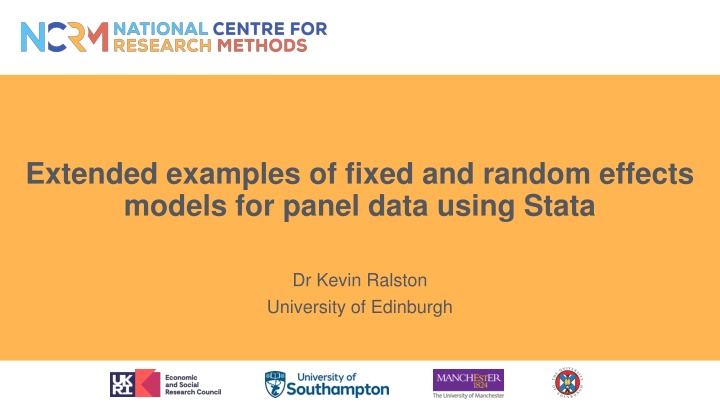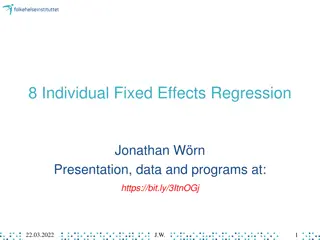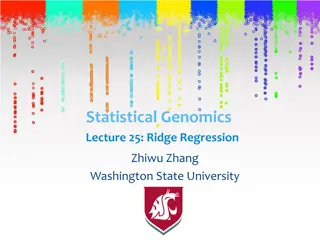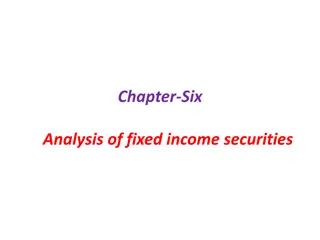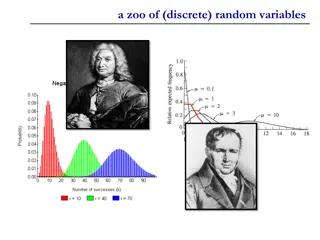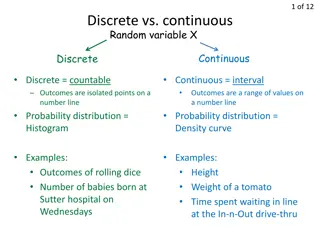Extended Examples of Fixed and Random Effects Models for Panel Data Analysis
Fixed and random effects models in panel data using Stata, as presented by Dr. Kevin Ralston from the University of Edinburgh. Learn about the structure of panel data, the Fixed Effects (FE) model which controls for stable unobserved variables, and the Random Effects (RE) model which considers random differences. Gain insights on individual effects and error terms in these models and understand key differences and uses between FE and RE approaches.
Download Presentation

Please find below an Image/Link to download the presentation.
The content on the website is provided AS IS for your information and personal use only. It may not be sold, licensed, or shared on other websites without obtaining consent from the author.If you encounter any issues during the download, it is possible that the publisher has removed the file from their server.
You are allowed to download the files provided on this website for personal or commercial use, subject to the condition that they are used lawfully. All files are the property of their respective owners.
The content on the website is provided AS IS for your information and personal use only. It may not be sold, licensed, or shared on other websites without obtaining consent from the author.
E N D
Presentation Transcript
Extended examples of fixed and random effects models for panel data using Stata Dr Kevin Ralston University of Edinburgh
The structure of panel data Subscript Levels i Level 2 e.g. individuals t Level 1 e.g. occasions
So, what is the Fixed Effects (fe) model? treats unobserved differences between individuals as a set of fixed parameters that can either be directly estimated or partialed out of estimating equations Allison 2009, p. 2
So, what is the Fixed Effects model? Control for all stable unobserved variables. Controls for variables that have not or cannot be measured. Each individual is their own control Controls within individual variation. This controls for all time invariant differences between individuals. Time varying differences can be included in the model. Cannot estimate time invariant variables (e.g. sex, ethnicity) Two requirements: The dependent variable must be measured at least 2 time points. Predictors must change across time point for a reasonable proportion of cases.
So, what is the Random Effects (re) model? Classically: individual differences are considered random variables drawn from a specified distribution (e.g. here: Teaching Sociology, University of Limerick) Now common to always regard the unobserved difference as random variables. Allison (2009) what distinguishes the approach from Fixed Effects: Defined by the structure of the association between observed and unobserved variables. Can account for change over time and time invariant variables The problem: assumes unobserved variables are uncorrelated (independent of) observed variables
???= ??+ ? + ?1?1??+ + ?????? + ?? ?? Individual effect, constant over time Fixed effects ???= ??+ ?1?1??+ + ?????? + ??+ ?? Two different error terms Random effects (random intercepts model) Adapted from Gayle and Lambert (2018)
Some key issues FE summarizes patterns of change within individuals Can estimate only explanatory factors which change over time Produces optimally low standard errors, because between subjects variance is not part of the error (consistent) RE analyses change within and between individuals Can estimate explanatory factors which change over time and also time constant ones Assumption that unobserved variables are uncorrelated with the observed More efficient, uses more information to estimate parameters See, Rabe-Hesketh and Skrondal (2008, p.124)
